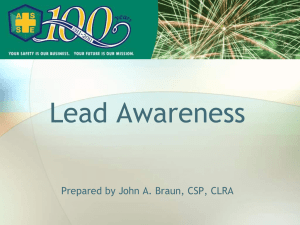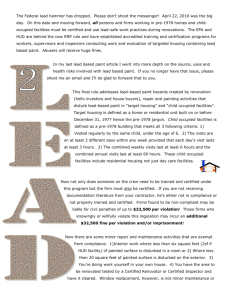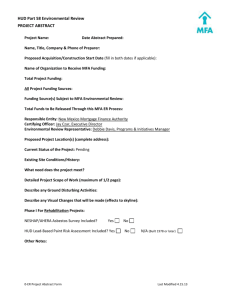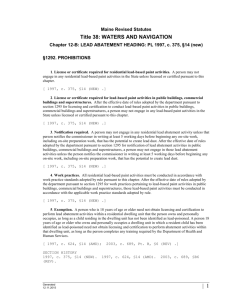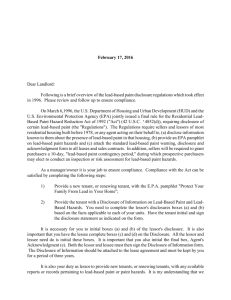training and study guide - Texas Department of State Health Services
advertisement
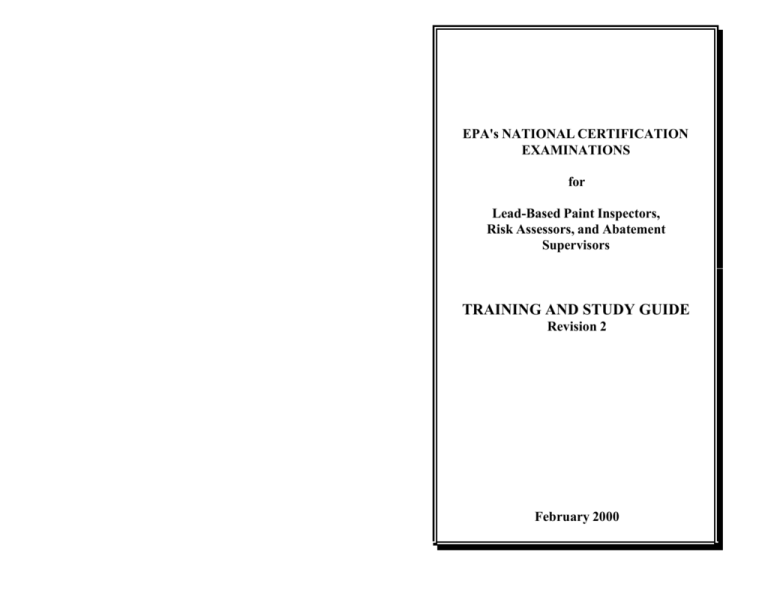
EPA's NATIONAL CERTIFICATION EXAMINATIONS for Lead-Based Paint Inspectors, Risk Assessors, and Abatement Supervisors TRAINING AND STUDY GUIDE Revision 2 February 2000 Contents Background ....................................................................1 Lead-based Paint Inspector Study Topics.....................2 Lead-based Paint Risk Assessor Study Topics .............4 Lead-based Paint Supervisor Study Topics ..................6 Study References ................................................ ..........8 E/00 Study References Background Inspector and Risk Assessor Examinations EPA Model Training Curriculum: Lead Inspector, April 1993. EPA Model Training Curriculum: Lead-Based Paint Risk Assessment, June 1995. (Risk Assessor only) Guidelines for the Evaluation and Control of Lead-Based Paint Hazards in Housing. HUD, August 1995. HUD 1012/1013 Rule (35 CFR 24), 9/15/99. Lead Disclosure Rule (35 CFR 24, 40 CFR 745), 3/6/96. EPA 402/404 Rule (40 CFR 745), 8/29/96. Supervisor Examination EPA Model Training Curriculum: Lead Abatement Training for Supervisors and Contractors, 1996-97 Revision. Guidelines for the Evaluation and Control of Lead-Based Paint Hazards in Housing. HUD, August 1995. Lead Paint Safety: A Field Guide for Painting, Home Maintenance, and Renovation Work. HUD and CDC, June, 1999. For information about obtaining references, call: HUD USER: 1-800-245-2691, or National Lead Information Center Clearinghouse: 1-800-424LEAD. 8 The U.S. Environmental Protection Agency (EPA) has promulgated regulations to ensure that individuals engaged in lead-based paint activities in target housing and child-occupied facilities are trained and certified. The regulatory text describes the criteria for Inspectors, Risk Assessors, Supervisors, Projects Designers and Abatement Workers. Under these standards, an individual must successfully complete an approved training course, secure a course completion certificate and satisfy certain prescribed education and experience requirements. Individuals seeking certification for Inspector, Risk Assessor or Supervisor must then successfully pass a National or State certification examination. EPA is not requiring certification examinations for Project Designer or Abatement Workers. National lead certification examinations have been developed to assist the States and EPA in meeting the mandatory requirement for an examination. The exams are based upon measurable training objectives to ensure that each individual certified under the program will have at least a minimum level of knowledge and understanding in their discipline. Subject Matter Experts, as well as EPA and State representatives were consulted throughout the development and evaluation of the exam questions. The lead-based paint abatement industry has evolved significantly in the last few years. Both EPA and the U.S. Department of Housing and Urban Development (HUD) have issued new regulations and guidelines for performing lead-based paint activities. Training curricula offered before 1995 may not have included these new and revised recommendations or requirements. In fact, EPA model curricula for both Inspector and Supervisor are currently under revision. Thus, if you are a training provider OR you are planning on taking a certification examination and have not attended a recent training course, you should carefully review the following detailed list of study topics that are included on the examination for the discipline of interest. The topics in ITALICS are either new requirements/guidelines or have been revised since the earlier training program development. For your convenience the individual topics are organized under logical headings. 1 Lead-based Paint Inspector Study Topics Lead-based Paint Supervisor Study Topics (continued) Initial Request for Inspection Abatement Site Preparation - Defining the scope of work Roles and responsibilities of an Inspector Difference between inspection and risk assessment 1 Difference between XRF and paint chip sampling Importance of State and local requirements HUD and EPA notification and disclosure regulations Health effects of lead in adults and children Routes of lead exposure Places where lead can be found inside and outside the home EPA recommended steps for reducing lead in drinking water Scope and goals of HUD and EPA lead regulations and guidelines Responsibilities of Public and Indian Housing Authorities Information about property needed to provide proposal for inspection Information about property needed to determine number of units to inspect Basic building and construction technology Liability issues involved in lead inspections Preparation for Inspection - Inspection scheduling Licensing and transportation of XRF How an XRF analyzer works Inspector and occupant safety during XRF use XRF calibration checks Equipment and forms needed for sampling OSHA regulations applicable to lead and respiratory protection Types of dosimeters Lead uses How to determine common construction history Calculation of number of units to inspect using HUD tables Random selection of units using HUD protocols Crew orientation How workers prevent taking lead dust home Shutting down and sealing HVAC systems Set up of shower, containment and critical barriers Required work area signs and waste labels Recommended and restricted methods for lead hazard control Limitations of control methods Lead Hazard Control Work - Potential health hazards from substances other than lead Health effects of lead on workers Proper use of personal protective clothing and equipment Material safety data sheets (MSDSs) Routine safety and health meetings Containment security and ventilation Air-sampling pump calibration Air sampling collection procedures and strategies - Reviewing air-sampling results and calculating TWAs Frequency and limits of medical monitoring of workers - Daily cleanup activities in abatement areas RCRA waste disposal regulations for abatement projects Final Cleanup and Clearance - - Pre-inspection Meeting - - Definition of "clean" for final clearance Proper order and procedures for final cleanup Surface-sealing application techniques Third-party visual inspection and wipe sampling for clearance Elements of the abatement report General Supervisory and Leadership Skills - Worker motivation Project management 1 Text in italics represents Study Topics that are either new or substantially modified for the National Lead Certification Examinations. These changes reflect either changes in regulations, or areas of increasing responsibility. 2 7 Lead-based Paint Risk Assessor Study Topics Lead-based Paint Risk Assessor Study Topics (continued) Initial Request for Lead Services Conduct Sampling (continued) - Types of lead evaluation protocol(s) Roles and responsibilities of a Risk Assessor 1 Difference between inspection and risk assessment Classification of EBL child Use of EBL questionnaire HUD and EPA notification and disclosure requirements Health effects of lead in children and adults Places where lead can be found Scope and goals of HUD and EPA regulations and guidelines Importance of State and local regulations Proposal to Perform Risk Assessment - Liability issues as they relate to risk assessment Types of insurance relevant to risk assessment Information about property needed to provide proposal for risk assessment Information about property needed to determine number of samples/units Estimating costs for lead evaluation work Risk assessment staffing OSHA regulations applicable to lead and respiratory protection Walkthrough - Background information about lead uses and sources Basic building construction and architecture Conditions when lead paint is considered a hazard HUD categories of paint condition and deterioration Causes of lead hazards Lead Hazard Screen - Number of paint samples to collect during screen Composite dust sampling for a screen Why composite are more stringent than single surface dust standards Interpretation of results of a screen - Targeted, worst-case and random sampling of MF dwellings Elements of a management plan for MF dwellings Interpretation of sampling results from MF dwellings Risk Assessment Report - Parts of the HUD standard risk assessment report Hazard control action alternatives/costs RCRA regulations for hazardous waste disposal Record retention requirements Ongoing Monitoring Conduct Sampling - Selection of soil sample locations Soil sampling procedures/equipment EPA/HUD hazard levels for lead in soil Water sampling procedures EPA drinking water lead standards and lead reduction steps Selection of paint sample locations Use of XRF analyzer and safety issues Performance characteristics sheets (PCS) Paint chip sample collection procedures Laboratory methods and accreditation programs for lead Calculation of ppm and mg/cm2 for lead in paint Assessing Multi-Family (MF) Dwellings Preparation for Risk Assessment - - Field documentation: testing location, sketches, HUD forms Selection of dust sampling location(s) Single surface and composite dust sampling procedures/equipment Calculation of dust concentration in ug/ft2 EPA/HUD hazard levels for lead in dust Spike and blank dust samples - Elements involved in ongoing lead hazard monitoring Schedules for reevaluation Clearance Testing - The final visual inspection of hazard control activities The number and location of clearance wipe samples 1 Text in italics represents Study Topics that are either new or substantially modified for the National Lead Certification Examinations. These changes reflect either changes in regulations, or areas of increasing responsibility. 4 5 Lead-based Paint Supervisor Study Topics Lead-based Paint Inspector Study Topics (continued) Clarification of Project Scope of Work The Inspection - - Reviewing the scope of the work Contract specifications 1 HUD and EPA guidelines and rules for lead-hazard control work Evaluation of lead inspection and risk assessment reports Liability issues involved with abatement work Types of insurance applicable to abatement Roles of all participants in an abatement project Record-keeping requirements for abatement projects Community relations plans Project budgeting Initial Walkthrough - Locations where lead-based paint hazards may exist in residences Basic building construction and architecture Work area isolation and site security Site storage of equipment and waste materials Location of containment barriers and shower Collection of pre-abatement (baseline) soil and dust samples Assemble Materials and Documents - Inventory of painted surfaces Testing locations in single family and multi-family dwellings Number of tests per testing combination and component type - Field documentation: sample location, sketches, and HUD forms - How to take XRF readings - - Performance characteristic sheets (PCS) XRF substrate corrections Interpretation of XRF readings Why POS, NEG and INCONCLUSIVE ranges vary among XRF analyzers Data collection from XRF testing HUD decision guidelines for paint chip sampling Collection of paint chip samples (ppm and mg/cm2) Laboratory and chain of custody forms Sample labeling Methods for analysis of lead Interpretation of lab results Use of chemical spot-test kits Soil sampling methods Dust sampling methods - OSHA Lead in Construction Standard – PEL, AL Definition of OSHA "competent person" Worker licenses and certification Acceptable baseline worker blood-lead levels - OSHA Hazard Communication and Respiratory Protection standards - How to summarize inspection results Contents of inspection report - OSHA Construction Standards (29CFR1926) - Site-specific health and safety programs Requirements for worker training Selection, fit and care of respirators Worker health and safety needs (other than respirators) Equipment and supplies used in lead hazard control work Materials used for enclosure and encapsulation - Recommendations an Inspector can make Inspection record retention requirements - Inspection Report - Clearance Testing - - - 1 Text in italics represents Study Topics that are either new or substantially modified for the National Lead Certification Examinations. These changes reflect either changes in regulations, or areas of increasing responsibility. 6 - The final visual inspection of hazard control activities Why pre-abatement wipe and soil samples are collected Why dust samples are collected for clearance The number and location of clearance wipe samples How to perform clearance wipe sampling Calculation of wipe sample results (ug/ft2) Wipe sampling clearance standards What happens when a wipe test fails Compositing clearance wipe and soil samples 3
![[Agency] recognizes the hazards of lead](http://s3.studylib.net/store/data/007301017_1-adfa0391c2b089b3fd379ee34c4ce940-300x300.png)
